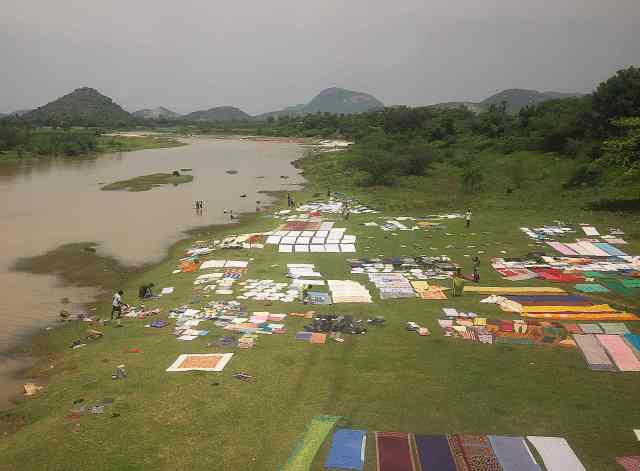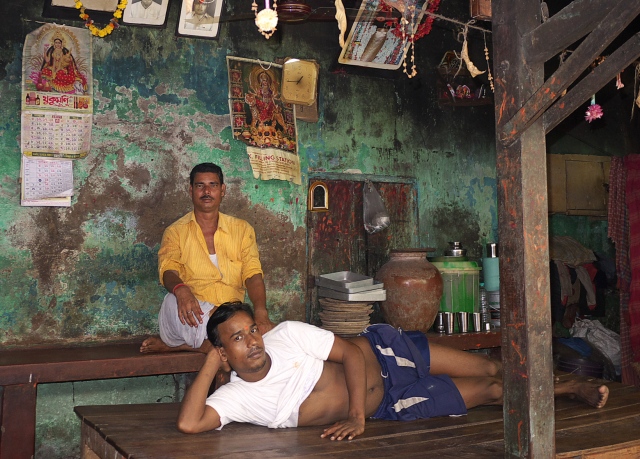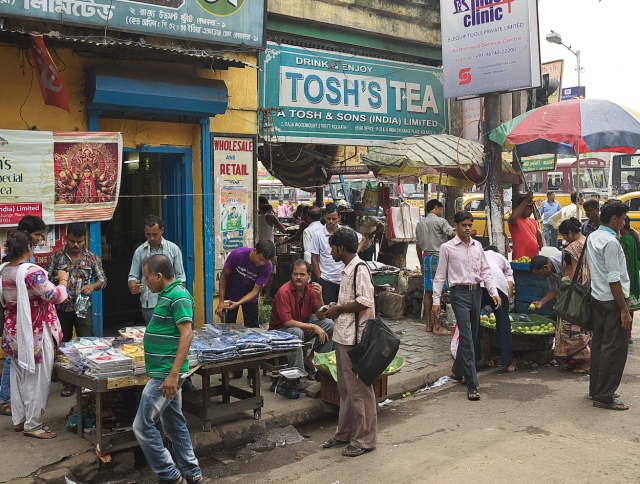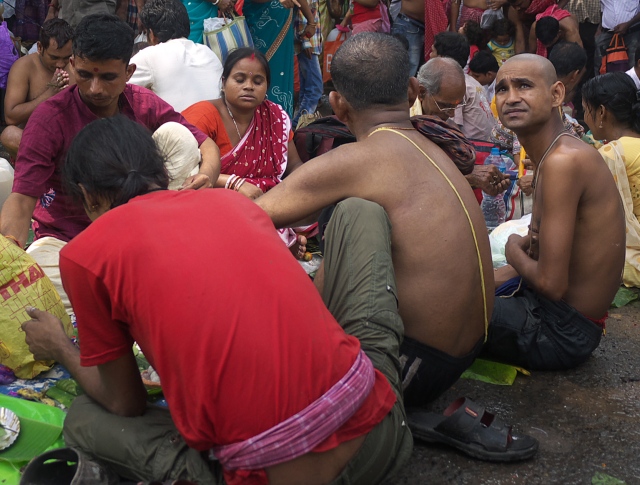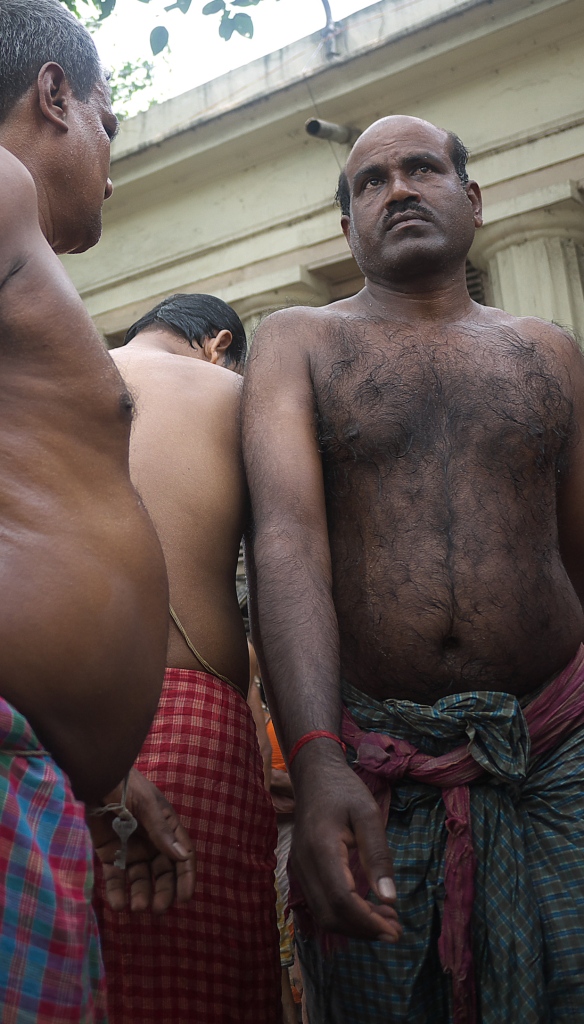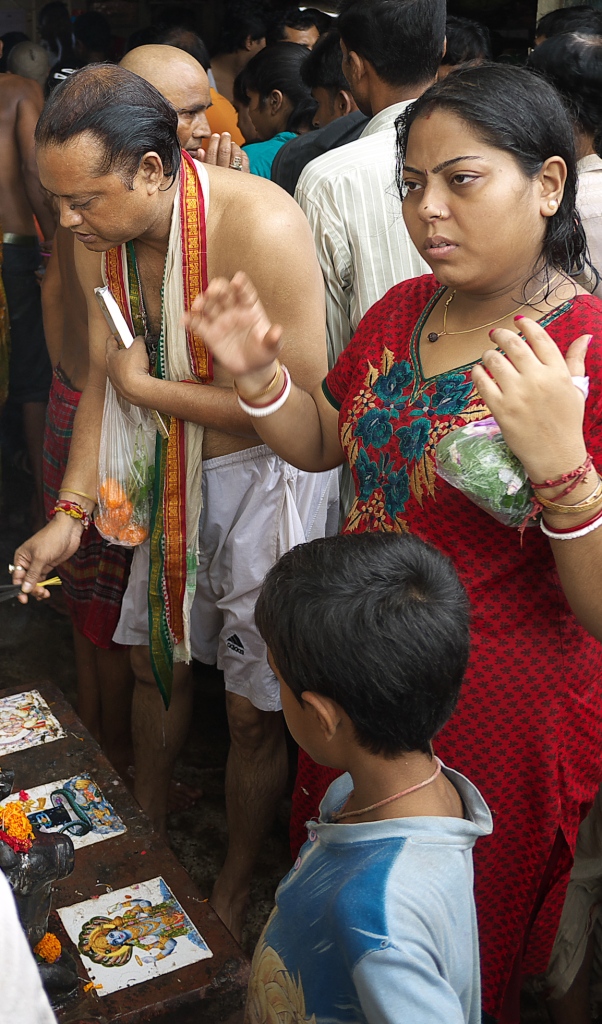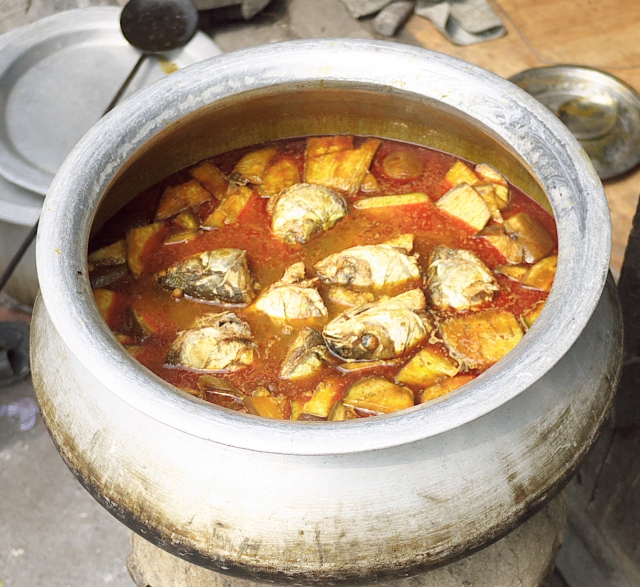” Poverty and Pride..Side by Side” Rudyard Kipling on Calcutta
“You are never alone in Calcutta” Michael Jennings
The Howrah Mail ( “ the superfastmail train of Indian railways connecting two metropolitan cities of India, Kolkata and Chennai” ..Fast is all rather relative when it comes to Indian Railways) arrives at four in the morning at Calcutta station.. and everyone stumbles out after 30 hours travel, relaxing for me in First Class AC sleeper, but for the multitudes from third class, laden down with boxes and cases it looked as though it had been an ordeal.
From past experience I queued up for the prepaid taxi, usually the best way not to get ripped off , but my yellow Ambassador cab driver had no idea of where we were going, another friend of a friend who got the chance to drive that night to earn a few rupees.
The streets are very badly lit at night and with a light drizzle one could just make out some of the many who sleep outside, often in or on their place of work; a tea stall, a roadside snack bar or a table selling clothes and the ever present street food stalls; and of the many rickshaw wallahs asleep in the back of their carts. There was lots of blue plastic waterproofing moving against the black background. At five in the morning it was a strange, surreal sight to see so many people creeping out from under their covers to start their day. It was a sight that will remain with me forever ..more fantasy than reality. It was my first experience of some post-apocalyptic world outside the cinema.
Venturing out from my hotel a few hours later, the sun was out and the temperature and humidity was already high..of a magnitude I hadn’t experienced before. The heat was accompanied by the noise, smell and the Calcutta crowds.
One noticed that the old 18th and 19thcentury British buildings were in a bad state with trees and bushes growing from the top and even out of the sides of these previuosly stuccoed edifices; and each building had a covering of tropical green moss and slime …rather like my hotel bathroom which had a fine coat of black/ brown growth, and I felt because of this humidity that if I stayed in one place too long I would become part of these aged green buildings of Kolkota and also be covered in green moss and perhaps even with a bush growing from my head.
.
Close to my hotel is the extraordinarily good and world famous bookshop, ‘The Oxford Bookshop’, a modern and well ordered place in the middle of chaos. I asked the staff who was the best contemporary Kolkata writer and without exception they all plumped for Amitav Ghosh, so I bought the recommended ‘Shadow Lines’, which turned out to be appropriate as it deals with post partition India (and Bengal) and the subsequent riots in both Dhaka and Calcutta. The air conditioning inside was outrageous, slightly uncomfortable while inside but the full effect is felt on leaving as one’s body has to cope with an unnatural change in temperature and my glasses, close to freezing took sometime for to demist as I stumbled around the tea stalls, vendors and hucksters.
Culcutta is not an old Indian City like Varanesi, Surat or Delhi but according to British & Raj legend entirely a construct of the British.
In the Seventeeth century there already existed on the banks of the Hooghy a number of small villages and an old burnt out trading Factory / Warehouse. According to legend .Job Charnock , employed by the East India Company and Governer of Bengal gave sacrifice at the Kali temple Kalikata, pitched his tents and proclaimed that the trading city of Calcutta would be built here. The British built Fort William in 1696 and during the 18th century the merchants of the east India company built mansions along side the river, and the city grew rapidly to be not only The Raj’s capital in India but the second city of the Empire.
However in 2003 The Calcutta High Court ordered Charnock’s name be expunged from all records. It was decided that a ‘highly civilised society’ and ‘an important trading centre’ had existed on the site of Calcutta long before the first European settlers came down the Hooghly; and that the name Calcutta was taken from the village of Kalikata and the city was therefore not founded by the British.
Kolkota is the cultural capital of India, and unlike other countries like China, Where Beijing has the Power and Culture and Shanghai Commerce; Turkey Istanbul being the cultural centre and Ankara the power; India has 3 capitals, Delhi for politics and power, Mumbai for commerce, business and banking and Calcutta for Culture.
The British era architecture, the faux mogul and the copies of 18th and 19th century Euro/classical architecture lends itself to a cultural centre.
In the late nineteenth century more books were printed in Calcutta than any other city in the world except London. This was during the late 19th- to early 20th-century, when you had a collision of British and Bengali culture leading to what is known as the Bengali Renaissance.Among famous Bengalis from this period were Rabindranath Tagore the first non westerner to win the Nobel Prize for Literature, and the the physicist C. Bose. It is surprising because today we think of Calcutta, as the epitome of Third World deprivation and poverty. But for a while it was a place of genius. Today some of the best Indian writers were born in here among them Amitov Ghosh, my current favourite writer.
For the last few weeks during my stay in both Chennai andKolkata I had always made sure that I had pockets of change and today I could give too which always helps blend in. As with previous religious ceremonies was the only western tourist and became a centre of attention for them and as usual many wanted their photograph taken with me.
Calcutta is one of those cities you can walk and set off in any direction and street life will reward you ..there are always people who want to chat, there are transactions, not only commercial being carried out where one can be entertained by just watching street life and of course partaking of the street food and endless cups of chai massala.
One day as I was crossing the Maidan I noticed groups of people heading in the direction of the river ..
Again just by chance, as in Chennai and Madurai, I was caught up in a religious ceremony and the exuberance and good humour of the occasion. I joined the crowd heading towards the river.
I asked one of the men dressed only in his lungi what was happening and I understood that everyone was heading to the Ganges / Hooghey for a ritual to do with Durga Puja. In fact I found out later that this festival of bathing and giving of offerings was the Mahalaya, where the goddess was called down to earth for the Festivities of Durga Puja , Bengalis most important religious festival. The eyes are drawn on the idols of the Goddess on this day, in an auspicious ritual called Chokkhu Daan. Durga Puja is a celebration of the Mother Goddess and victory of the goddess Durga over the evil Buffalo Demon Mahishasura.The Festival honours The powerful Female Force SHAKTI.
Th road leading to the Baboo Ghat was a line of not only of the poor begging but it seems on this special day the deformed, handicapped and blind had pride of place and that all the pilgrims on their way to bathe and give offerings also gave generously, money and sometimes food.
For the last few weeks during my stay in both Chennai andKolkata I had always made sure that I had pockets of change and today I could give too which always helps blend in. As with previous religious ceremonies was the only western tourist and became a centre of attention for them and as usual many wanted their photograph taken with me.
.
The semblence everyone together was pervasive and gifts and snacks were passed around. A Babu said a prayer for me and smeared a redspot, Bindi, on my forehead not asking for money, unusual in India.
Many were having their heads shaved before bathing and nearly all bought small offerings on a large leaf to float on the river.
The crush to get to the river at its most auspicious point was rather frightening and I was carried along with the crowd to the waters edge only just surviving a dunking by some friendly worshippers.
.
.
Ceremonies like this bring out the best in everyone including me and I left with a feeling of euphoria.
.
Bengalis are different from the rest of India in so many ways. Culturally and Politically.
The fight for independence from the British was strongest here in Bengal, and later West Bengal with Chandra Bose being the most famous of Independence fighters . Breaking with Gandhi in the 1930’s he went on to ally with the Germans and Japanese during the Second World War in the hope of an Axis victory. His Free Indian Legion was finally defeated with the Japanese at the Battle of Kohima in Indian Nagaland (which I visited recently ..more later).
After Independence West Bengal continued it’s different and long standing anti-establishment political path to Delhi and in 1977 democratically voted in power The Communist Party of India after a number of years of a left dominated United Front. Near the Maidan there are Statues of Marx, Lenin and Chandra Bose, in little gardens still well tended.
Bengal was both a highly developed Industrialised and Peasant farming society under the British and both sectors were highly developêd with organisations with demands for workers rights and strikes in the Industrial sector and demands for a third of the crop they produced by the peasants. The British had built a number of world class eductional colleges and left West Bengal with a strong civil society, more likely to vote freely and not coerced by landlords or on religious or caste lines.
This raised class consiousness , combined with a more secular and multi religious population, led to the election of the Communist Party party dominated United Front and later ruling on their own.
Religion and caste was less important here and Sati was first banned here along with developed womens rights in general, even widow remarriage was organised , developments unheard of today in many other regions of India.
Since 2011 a union of the two Congress Party factions have controlled West Bengal, some saying they are further to the left than the CPI-M.
West Bengal under The Communist party, with little help from central government, extended education and the Universal healthcare system and therefore like Kerala produced a literate workforce that attracted companies there.
further reading
https://www.quora.com/Why-is-Communism-so-successful-in-West-Bengal.
Mulik Ghat
For great entertainment the Mulik Ghat Flower market next to the River and Howrah Bridge is a must. It is reputed to be the largest in India and although nothing dominates the market like the orange and yellow marigolds, which are widely used for religious rituals there are roses and other flowers and of course the ubiquitous beetle leaf used in the narcotic Paan. Paan is a preparation combining betel leaf with areca nut, lime and sometimes also with tobacco. It is chewed for its stimulant and psychoactive effects and is not only very addictive but rots teeth.
.
Paan is a preparation combining betel leaf with areca nut, lime and sometimes also with tobacco. It is chewed for its stimulant and psychoactive effects and is not only very addictive but rots teeth.
.
It is really a mini city on it’s own, with lots of shanty restaurants and with most traders living in their small huts with their merchandise, and washing in the river in the morning. A sight I missed is the wrestling at dawn by the river.
.
.
Bengali street food in Kolkata is the best in India and there is so much choice. Every inch on every corner is taken by semi-permanant or commando food stalls.
This arrangement of shops and stalls, whereby that of the pavement next to the road became a second line of commercial though less permanent structures, first came about after partition when many traders from the eastern part of Bengal fled to Kolkota and was reinforced with more refugees after the creation of Bangladesh in the seventies.
Kolkota is a city that has grown on waves of refugees from the early nineteenth century onward. And for the most part the British were the cause of these waves of refugees, from famines, ousting of peasants from their land for non-payment of taxes to short sighted political divisions.
There is firm belief that the origins of the Mutiny and so called Black Hole of Calcutta lay in the onerous taxes the British, in the form of the East India Company, levied on the small farmers forcing them off their land.
.
Central Kolkota from the New Market area to Nehru Road ( the old Chowringhee Road) is the seriously busy part of town. Nehru Road has one such double row of shops and eateries, the second taking over the pavement area next to the street, leaving only a narrow pedestrian pavement to negotiate both the traders from the old established shops and the once fly by night but very now stalls and restaurants. Cloth and plastic was hung overhead to keep the fierce sun from both peddlers and customers.
The 1943 Bengal famine, or the Forgotten Famine was the a combination of weather but the British comandeering food for the war effort was the main cause.. The British were often behind famines in Bengal, notably forcing peasants to grow opium poppies rather than food but the famine of 1943 could be laid firmly at the door of the british diverting rice to Europe ..Churchill was directly involved and asked why he did it he replied
“I hate Indians. They are a beastly people with a beastly religion. The famine was their own fault for breeding like rabbits.”
There are many wild estimates of how many deaths were caused during the 300 years of by the British rule either through famine, war and retribution. They range from around 200 million to 1.8 billion, but it is generally assumed that a conservative 300 million is correct.
.
The Kalikata Temple area has a different feel to central Calcutta. Perhaps it is because it is part of the oldest part of the city standing. Part of the area near the Black Hole and the old city was raised to the ground by the British.
There are many pilgrims here and consequent merchants and beggars but it was quite relaxed.
..
.
Central Kolkata is a busy place with many people spending most of their lives on the Streets. Many sleep where they work, beg and play so one sees everything from sleeping, washing, eating or even having a dispute. But generally everone appears to get somehow get on.
.
.
.
Probably the most remarkable building, along with the Court House is the marble Victoria Memorial. Planned in 1901 on Victoria’s death, construction started in 1906 and finished finally in 1921 ten years before the capital moved to New Delhi. Kept immaculate on the outside the exhibits in the museum, especially the maps, prints and paintings have suffered Under Calcutta’s climate.
An anecdote to finish
The Oberoi hotel chain started in Calcutta in 1939.
The previous hotel was closed down after7 people died of Typhoid. Mohan Oberoi bought cheaply a lease on the building and cleaned the drains and disenfected the rooms, and his breakthrough as war started was to offer rooms to the British Army well below market rates as he realised he would make a fortune selling soldiers drink. So much so that by 1943 he bought the hotel outright…..
I have only shown a few images from this exceptional city and few more can be seen at
Next ..Durga Puja in Katmandu …



